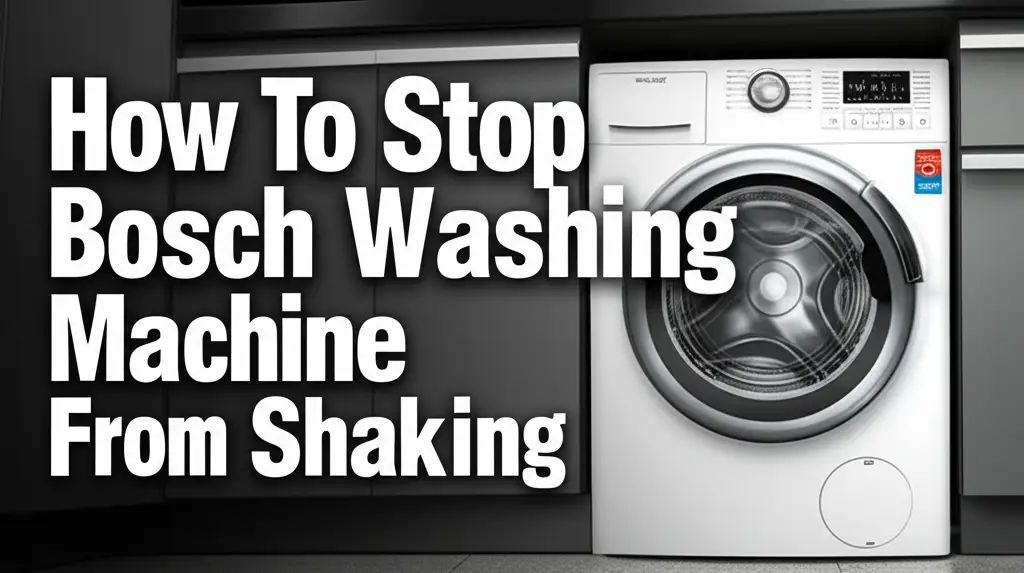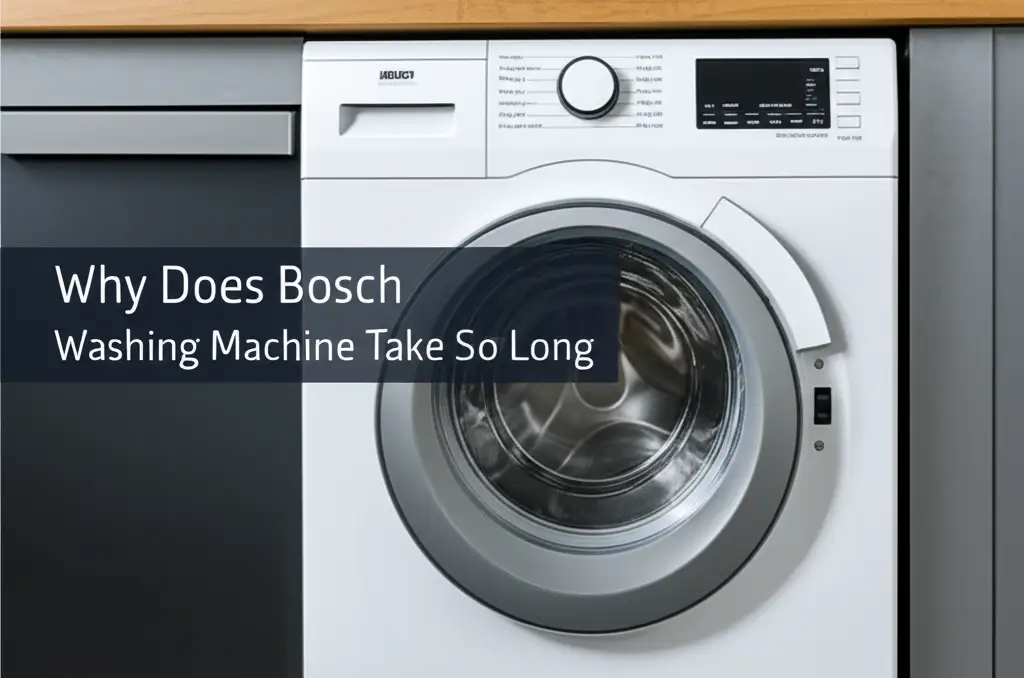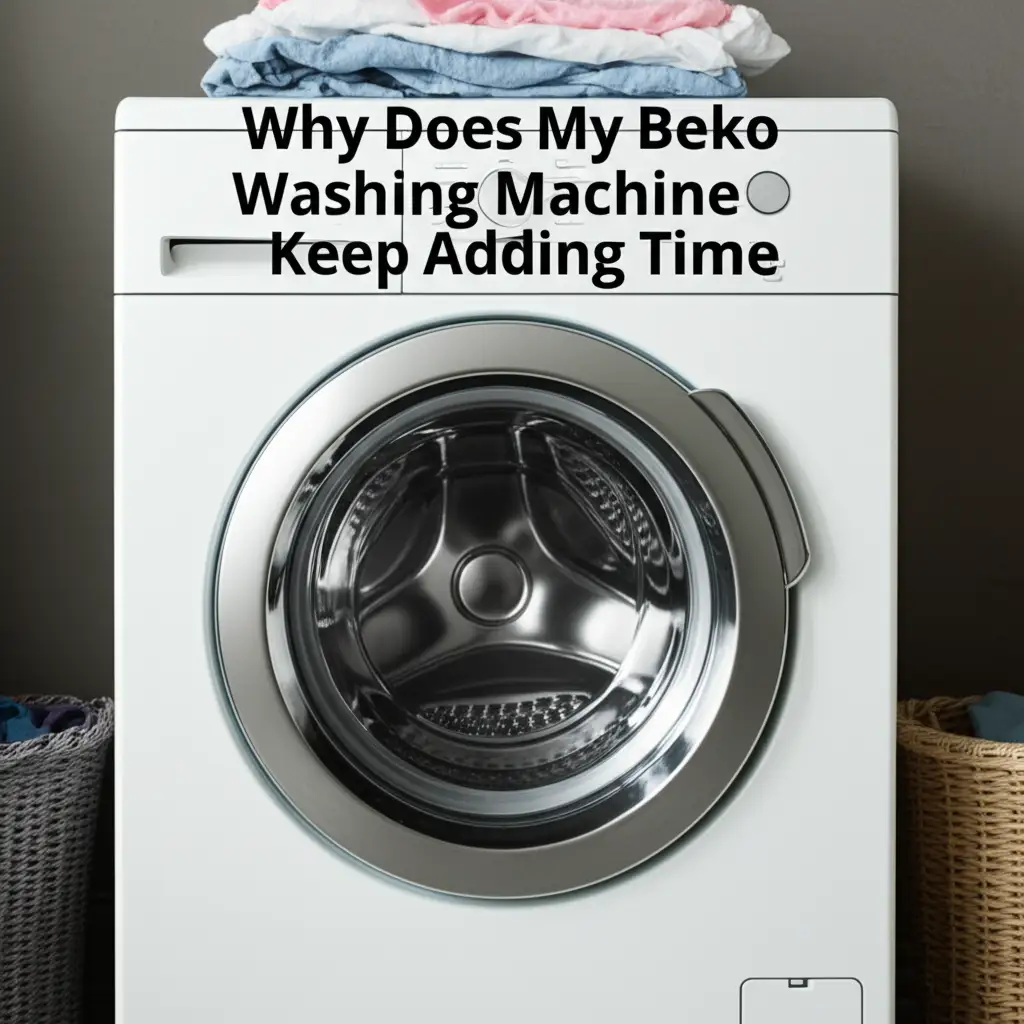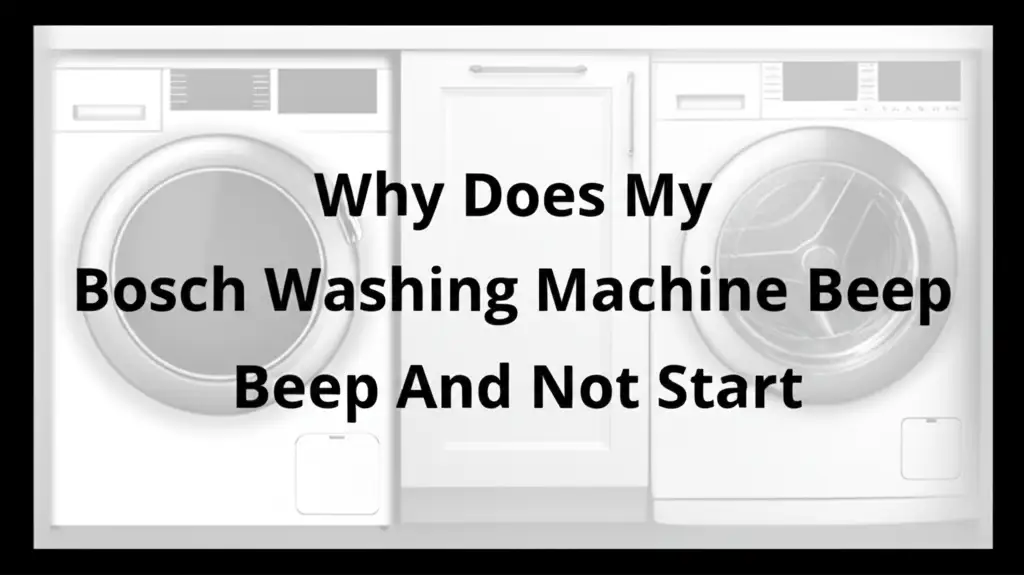· Todd Martin · Home Appliances · 16 min read
How To Stop Bosch Washing Machine From Shaking

Stop Your Bosch Washing Machine From Shaking
Is your laundry room turning into a dance party every time your washing machine spins? A shaking Bosch washing machine is more than just an annoyance. It can signal problems that might shorten your appliance’s life. I understand how frustrating a vibrating washing machine can be. This common issue affects many households. It also puts stress on the machine’s internal parts. You want to make your laundry routine peaceful again. This guide helps you identify and fix the reasons behind the noise. We cover everything from simple adjustments to deeper fixes. We will explore common causes of washing machine vibrations. We will show you how to troubleshoot them yourself. Get ready to enjoy a quieter laundry day.
Takeaway
- Balance the load: Ensure clothes are evenly distributed.
- Level the machine: Adjust the appliance’s feet for stability.
- Remove shipping bolts: Check for and remove these on new machines.
- Inspect parts: Look at shock absorbers and bearings for wear.
- Use anti-vibration pads: Add these under the machine for extra stability.
To stop your Bosch washing machine from shaking, first check for an unbalanced laundry load. Then, ensure the machine sits level on the floor by adjusting its feet. For new machines, remove all shipping bolts. If problems continue, inspect internal parts like shock absorbers or drum bearings.
Understanding Why Your Bosch Shakes
It can be alarming when your Bosch washing machine starts to shake. This problem often appears during the spin cycle. Many factors can cause this vibration. Knowing the cause helps you fix the issue. We will explore the main reasons why your Bosch appliance might shake.
An unbalanced laundry load is the most common reason for shaking. Large, heavy items can clump together. This makes the drum uneven during spinning. The machine tries to spin this heavy spot. This causes the entire unit to rock violently. Think about trying to balance a spinning top with a weight on one side. It wobbles a lot. Your washing machine does the same.
Another frequent cause is an uneven floor or unadjusted leveling feet. Washing machines need a stable base. If one foot is higher than another, the machine will rock. It will especially rock during high-speed cycles. This is like a table with a short leg. It wiggles when you lean on it. The machine needs all its points of contact to be firm.
Shipping bolts are a less common but critical issue, especially for new machines. Manufacturers install these bolts to secure the drum during transport. This prevents damage. If you do not remove them before using the machine, the drum cannot move freely. This causes extreme shaking. Always check the manual for bolt removal instructions. Failing to remove them can cause serious damage. You might see similar problems with other brands if shipping bolts are left in. For example, why is my Whirlpool washing machine shaking violently often points to similar installation issues.
Worn internal components can also be the culprit. Over time, parts like shock absorbers or suspension springs wear out. These parts help cushion the drum’s movement. If they fail, the drum moves too freely. This results in shaking. Bad drum bearings can also cause a loud grinding noise and shaking. The bearings allow the drum to spin smoothly. If they are faulty, friction increases and movement becomes jerky. We will discuss how to check these parts later.
The First Step: Check the Load
A common reason for your Bosch washing machine shaking is an unbalanced laundry load. This happens more often than you might think. Getting the load right can fix the problem quickly. I always start here when my machine vibrates.
First, open the washing machine door and look inside. Are all your clothes piled up on one side of the drum? This uneven distribution creates a heavy spot. When the machine spins, this heavy spot causes an imbalance. The machine then tries to correct this. This makes the entire appliance shake or walk across the floor.
To fix this, redistribute the items. Pause the wash cycle. Then, manually spread out the clothes. Move them around until they look more evenly spread. Avoid washing just one heavy item like a blanket or a large rug by itself. These items are very likely to cause an imbalance. Instead, add a few smaller items with them. This helps balance the load.
Overloading your Bosch washing machine also causes shaking. A machine full to the brim cannot distribute clothes properly. The items get compacted. This prevents the water from moving freely through them. It also makes the drum heavier than designed. This extra weight, poorly distributed, leads to strong vibrations. The machine works harder, creating more noise and movement.
Underloading can also cause issues, though less often. Washing only one or two small items can also create an imbalance. These few items might stick to one side. This causes the same problem as an unbalanced large load. It is always best to put a reasonable amount of laundry in the machine. Aim for a load that fills about three-quarters of the drum. This allows clothes to tumble freely and water to circulate well. Proper loading helps your Bosch washing machine spin only smoothly. By taking care of the laundry load, you often solve the shaking issue.
Leveling Your Bosch Washing Machine
Once you have checked the laundry load, the next step is to ensure your Bosch washing machine is level. An unlevel appliance is a major cause of shaking and noise. It is like trying to build a tall tower on a crooked base. The whole thing wobbles easily. I make sure to check the level of my own washing machine regularly.
First, you need to check if your machine stands level. You can use a spirit level for this. Place the spirit level on top of your Bosch washing machine. Check it from front to back and then from side to side. The bubble in the level should be centered. If it is not, your machine is not level. You might notice the machine rocks if you push on a corner. This also tells you it is not stable.
Bosch washing machines have adjustable feet. These feet are usually at the bottom corners of the machine. Most models have four feet. You can raise or lower each foot. This helps you balance the machine on an uneven floor. You often turn the feet clockwise to lower the machine and counter-clockwise to raise it. Some models might have a locking nut near the foot. Loosen this nut before adjusting. Tighten it again firmly after you make the adjustment. This secures the foot in place.
Adjusting the feet takes some patience. Raise or lower one foot at a time. Then, recheck the level with the spirit level. Repeat this process until the bubble is centered in both directions. All four feet should sit firmly on the floor. No foot should be hanging in the air. If the machine still rocks after leveling, one foot might be too loose. Ensure all locking nuts are tight.
For extra stability, consider using anti-vibration pads. These pads sit under each foot of the washing machine. They are often made of rubber. They help absorb vibrations. They also prevent the machine from sliding on smooth floors. These pads are an inexpensive solution. They provide added peace of mind. Placing them under a perfectly level machine can still reduce noise. They make the operation even quieter.
Removing Shipping Bolts (Crucial for New Machines)
If you have a new Bosch washing machine, or one that has just been moved, shipping bolts are a critical check. These bolts are essential for safe transport. However, they must be removed before you use the machine. Failing to remove them is a common mistake. This error causes severe shaking. I have seen many people forget this step.
Manufacturers install shipping bolts to protect the washing machine drum during transit. The drum is suspended inside the machine. Without these bolts, the drum would bounce around during shipping. This could damage internal components like springs or hoses. The bolts hold the drum firmly in place. This prevents any movement.
You will typically find shipping bolts at the back of the washing machine. There are usually three or four of them. They often have large plastic heads or colored caps. Your Bosch owner’s manual will show their exact location. It will also provide clear instructions on how to remove them. Always refer to your specific model’s manual. The manual is your best friend for setup.
Removing the bolts is usually simple. You might need a wrench or pliers. Simply turn the bolt counter-clockwise until it comes out. Once removed, store these bolts in a safe place. You will need them if you ever move the washing machine again. Many machines come with plastic caps to cover the holes after removal. Insert these caps into the holes. This helps keep dust and debris out.
If you use your Bosch washing machine with the shipping bolts still installed, the drum cannot move freely. It will be rigid. During the spin cycle, the drum tries to move and balance itself. But the bolts restrict it. This causes extreme vibration. The machine will shake violently. This can damage internal parts. It can even damage the floor or nearby walls. Always make sure these bolts are out before your first wash. This small step saves you big problems.
Inspecting Internal Components (Advanced Troubleshooting)
If your Bosch washing machine still shakes after checking the load, leveling, and shipping bolts, the problem might be inside the machine. This is where more advanced troubleshooting comes in. Some internal parts wear out over time. This can cause vibration. Knowing what to look for helps you decide if you can fix it or if you need a professional.
One common internal issue involves the shock absorbers or suspension springs. These parts support the drum. They absorb the vibrations created during the spin cycle. Over many years of use, they can weaken or break. If a shock absorber fails, the drum’s movement becomes uncontrolled. This leads to excessive shaking. You might hear a knocking sound as the drum hits the machine’s casing. You can usually access these parts by removing the back panel of your Bosch washing machine. Look for any broken springs or leaky shock absorbers.
Another critical component is the drum bearings. Bearings allow the inner drum to spin smoothly. If the bearings wear out, the drum will wobble. You might hear a loud grinding or rumbling noise, especially during the spin cycle. This noise gets louder as the problem worsens. Checking bearings often requires removing the drum. This is a complex task. It is often best left to a professional. If your Bosch washing machine is not working or making strange noises, bad bearings could be the reason.
The drive belt is another part to check. This belt connects the motor to the drum pulley. It helps the drum spin. If the belt becomes worn, stretched, or broken, the drum might not spin correctly. It could also slip, causing jerky movements and vibrations. Open the back panel to inspect the belt. Look for cracks, fraying, or looseness. Replacing a drive belt is a relatively straightforward repair for someone with basic appliance repair skills.
Inspecting these components often requires tools and some knowledge of appliance repair. Always unplug the machine before you begin any inspection. Safety is paramount. If you are not comfortable working with appliances, do not attempt these repairs. Consider seeking professional help. A technician has the right tools and expertise. They can correctly diagnose and fix these internal issues.
Regular Maintenance for a Stable Machine
Preventing your Bosch washing machine from shaking starts with regular maintenance. A well-maintained appliance runs smoother and lasts longer. Simple habits can reduce the chance of developing vibration problems. I have found that a little care goes a long way with home appliances.
Proper load management is key. We discussed this earlier, but it bears repeating. Always distribute clothes evenly in the drum. Avoid throwing everything in one lump. Mix large items like towels with smaller ones. Do not overload the machine. This puts stress on the motor and suspension system. It also causes imbalance. A balanced load helps the machine run smoothly during all cycles. This includes the high-speed spin cycle.
Periodically check your machine’s level. Floors can settle over time. The machine’s feet can also loosen. Use a spirit level every few months. Re-adjust the feet if needed. This ensures the machine stays stable. A level machine puts less strain on its internal parts. This helps prevent shaking.
Cleaning your Bosch washing machine also helps. Dirt and residue build up inside. This can affect performance. Clean the detergent dispenser regularly. Also, clean the drum. Some Bosch machines have a drum clean cycle. Use this cycle with a washing machine cleaner. This removes mold, mildew, and detergent residue. A clean drum ensures clothes move freely inside. For detailed steps on how to clean your front-load machine, you can check out guides like how to clean Bosch washing machine front load.
Do not forget the pump filter. Lint and small items can clog the pump filter. A clogged filter can affect water drainage. This might lead to issues with the spin cycle. An inefficient spin cycle can sometimes contribute to unbalanced loads and shaking. Consult your manual to locate and clean the pump filter. It is usually found at the bottom front of the machine. Cleaning it is a quick task. For example, learning how to clean Bosch washing machine pump filter can prevent future problems. Regular filter cleaning is a simple but important maintenance step. These simple steps keep your Bosch appliance running smoothly. They reduce the risk of annoying shakes and vibrations.
When to Call a Professional (Safety First)
Sometimes, despite your best efforts, your Bosch washing machine continues to shake. Or, you might find issues that are beyond your comfort level to fix. In these situations, calling a professional appliance technician is the safest and smartest choice. Knowing when to stop DIY repairs protects you and your machine.
If you have tried all the basic troubleshooting steps, and the shaking persists, it is time for expert help. This means you have checked the load, leveled the machine, and confirmed shipping bolts are removed. If the machine still shakes violently, it likely has a deeper internal problem. This could be worn out drum bearings, a damaged motor, or a broken suspension system. These repairs require specialized tools and knowledge. Attempting them without proper training can cause further damage. It can also pose a safety risk.
Persistent loud noises combined with shaking are also a red flag. A grinding, banging, or screeching sound often points to a serious mechanical failure. This could be worn bearings or a broken motor. Ignoring these noises can lead to complete machine failure. It can also create a fire hazard or electrical danger. A professional can diagnose these sounds accurately. They can then perform the correct repair.
Safety is the most important factor. Washing machines combine water and electricity. This makes them potentially dangerous. If you are unsure about any repair step, do not proceed. Do not work on an appliance that is plugged in. Always disconnect power first. If you lack experience with electrical components or heavy machinery, a technician is essential. They follow strict safety protocols. They have the training to handle these powerful machines safely.
Consider the cost versus the benefit. Some internal repairs are expensive. A professional can give you an estimate. They can help you decide if repair is more cost-effective than buying a new machine. They can also explain why your Bosch washing machine is not working due to the shaking. Professionals can often resolve complex issues quickly. This saves you time and frustration. It also ensures the repair is done correctly.
FAQ Section
Why does my Bosch washing machine shake so much during the spin cycle?
Your Bosch washing machine most likely shakes during the spin cycle due to an unbalanced load. Heavy items can clump together, causing the drum to spin unevenly. Check that clothes are spread out inside the drum. Overloading the machine can also cause this problem. Ensure you are not filling the drum too full.
Can anti-vibration pads really stop my Bosch washing machine from shaking?
Yes, anti-vibration pads can significantly reduce shaking and noise. They are made of rubber or other dampening materials. These pads sit under each of the washing machine’s feet. They absorb vibrations and prevent the machine from “walking” across the floor. They work best when the machine is already level.
How often should I check my Bosch washing machine’s level?
You should check your Bosch washing machine’s level at least once every six months. Floors can settle, and the machine’s feet can loosen over time. Regular checks ensure your appliance remains stable. This prevents unnecessary stress on internal components and reduces shaking during cycles.
Is it dangerous if my Bosch washing machine shakes violently?
Violent shaking can be dangerous. It can cause the machine to “walk” and potentially damage walls or other appliances. Prolonged violent shaking can also damage the machine’s internal parts, leading to breakdowns. In severe cases, it could cause electrical issues or leaks. Address violent shaking immediately.
What are shipping bolts, and do all Bosch machines have them?
Shipping bolts are protective bolts installed by manufacturers to secure the washing machine drum during transit. This prevents damage to the suspension system. Most, if not all, new Bosch washing machines have them. You must remove them before the first use. Consult your machine’s manual for their exact location and removal instructions.
Can an unbalanced load damage my Bosch washing machine?
Yes, a consistently unbalanced load can damage your Bosch washing machine over time. The constant violent shaking puts strain on the motor, drum bearings, and suspension system. This can lead to premature wear and failure of these components. It can also cause the machine to move and potentially damage its surroundings.
Conclusion
A shaking Bosch washing machine does not have to be a permanent fixture in your laundry room. I hope this guide helps you diagnose and fix the issue. We covered everything from simple load adjustments to more complex internal checks. Remember, addressing the problem early saves you from bigger headaches down the road. Most shaking issues stem from common causes. These include an unbalanced laundry load, uneven flooring, or forgotten shipping bolts. You can often solve these yourself with simple steps.
By regularly maintaining your appliance, you ensure its smooth operation. Check the level, manage your loads carefully, and keep it clean. These practices extend your Bosch washing machine’s life. If you still hear grinding noises or the shaking remains severe, do not hesitate to call a professional technician. Your safety and the machine’s longevity are important. Take action today to enjoy quieter, more efficient laundry days. Stop that Bosch washing machine from shaking.
- Bosch washing machine
- washing machine shaking
- appliance repair
- washing machine troubleshooting
- laundry tips





